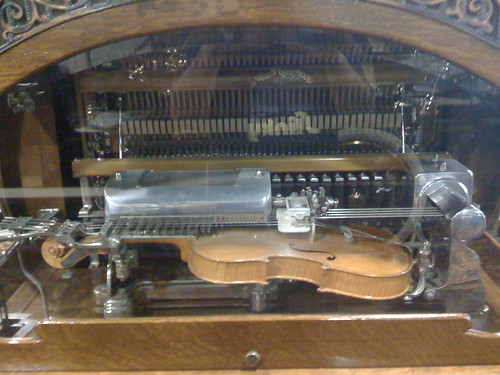Violano Virtuoso in Sylmar
Today, on the spur of the moment, I decided to visit the Nethercutt museum in Sylmar, which I had heard about a couple of years ago when I was researching automatic music instruments. The museum, an unexpected display of wealth that sits on the corner of an industrial park in an economically depressed area — all yard sales, grafitti and auto repair shops — is one of the San Fernando Valley’s hidden gems. I am reminded a bit of the gustatory majesty that is Brent’s Deli, sitting in an unassuming strip mall next to a carpet outlet in Northridge.
Most people visit this place for the classic cars, which are clearly the focus of the collection. The museum houses well over a hundred antique, classic and unique cars, including lots of Packards, Deusenbergs and Rolls Royces.
I am more interested, however, in automatic music instruments, so I happily skipped past the gleaming vehicles to check out the nickelodeons, orchestreons and music boxes that can be found, mostly unlabeled, in a central aisle of the museum. A lot more instruments, including a Wurlitzer Theatre Organ, are housed in the imposing edifice across the street, but this requires a guided tour to see. A very muscular security guard blocked the doorway, so I’ll have to come back after making reservations, or perhaps attend one of the occasional silent movie and organ concerts.
One of the most interesting instruments on display in the auto showroom is a Bow Front Violano Virtuoso, shown above. According to various sources only 13 to 17 of these bow front models are known to exist. The specimen at the Nethercutt museum still works, and many of the patrons inserted nickels to hear it play “old-timey” music, perhaps unaware that the machine they are putting their nickels into is worth about 3 or 4 million nickels.
I took a few close-up photos with my cell phone of the prominently displayed automatic violin mechanism, which is very cool. There is a set of 4 rotating wheels which act as a bow on each string. Each wheel receives rosin from a feed which sits above the bow wheels. The strings are separated from the fingerboard of the violin, and connected to what appears to be an automatic tuning mechanism. When played, the strings are pressed with a series of metal fingers. The mechanism appears to have been inspired, in part, by the Hurdy Gurdy, which dates back to the 10th century.
On Tim Trager’s Website, there is a very cool set of photos of a scanned brochure showing the Mills Novelty factory where these instruments were made, around 1915. A couple of the cards are shown below.





March 26th, 2009 at 8:49 pm
I also like the Slinky T-shirt. Check the reflection.
March 30th, 2009 at 1:15 pm
I was just stopping by for a Kakuro puzzle! The only parallel I know of is a Mills Double Violon, which is similar to the machine you talk about. The recordings I’ve heard are all very “liberal” about the tuning, which makes them a lot of fun. Reminds me of growing up in Santa Cruz, CA. The Ruth Band Organ at the Carousel was only tuned at the beginning of the season. Months later, it had drifted into atonal territory. No wonder I grew to like the avant-garde. If you look around used record places, you can find many recordings of old automatic music instruments, few of which were updated to CD. I have a fairly wide collection, which were obtainable for comparatively little money. Thanks for sharing!